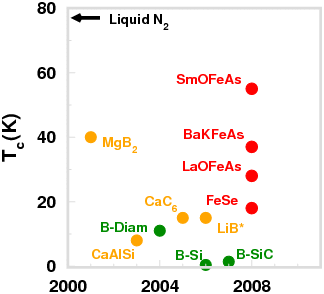In 100 words (Technical):
My main research activity involves the study of novel superconductors, using ab-initio (DFT)
methods. For standard electron-phonon superconductors, linear response calculations, together
with Migdal-Eliashberg theory, can be used to calculate and predict the superconducting critical temperatures.
Downfolding methods permit to obtain a clear physical picture of the bonding ...
A longer, techincal description of my recent research activities can be downloaded in pdf
format.
Recent Discoveries :
The picture below shows some of the most recent discoveries in the field of superconductivity.
It is not meant to be exhaustive, as it is only showing systems I have been working on, but
I hope you find it interesting ;)

You can also have a look at the picture at the bottom of the page, which instead shows the
discoveries of "last century"...
2001: Hexagonal s-p Superconductors:
The yellow dots represent s-p hexagonal superconductors; these are all compounds, which do not contain d elements, in which superconductivity is caused by electron-phonon interaction; they share a common crystal structure, formed by hexagonal planes of boron, carbon (Al,Si), intercalated by alkali atoms or alkaline earths. If you would like to learn something more on my work on these systems, click here.
2004: Doped Semiconductors:
The green dots represent semiconductors, which
become superconductors upon doping.
Although superconductivity in n-doped superconductors was
postulated in the late Fifties, and observed at temperatures < 1K
in the following years, the field has attracted considerable interest
only after the discovery of superconductivity in boron-doped
diamond in 2004.
If you would like to learn something more on my work on these systems,
click here.
2008: Iron-based Superconductors:
In February 2008, superconductivity was discovered in fluorine-doped LaOFeAs, a layered material containing layers of Fe and As, separated by spacer layers of La and O, with a critical temperature ($T_c$) of 26 K. In a few months, several analogue compounds, with other rare earths substituting La, have been synthesized, with $T_c$ as high as 55 K. Besides this class of compounds, known as 1111, two other classes of fe-based superconductors, with similar but simpler structures, have been found: 122 compounds, such as BaFe$_2$As$_2$ and FeSe. If you are interested in my activity in this field, click here.
Background :
If what you have read so far doesn't make sense to you, you would probably first like to read something
about Superconductivity or Density Functional Theory...
But for a short history of superconductivity probably the picture below (courtesy of G.B. Bachelet) suffices...

1911: Superconductivity with Tc=4.2 is observed in solid mercury by H.K. Onnes.
1957: The Bardeen-Cooper-Schrieffer (BCS) theory is formulated: superconductivity is caused
by the condensation of pairs of electrons (Cooper pairs), which are held together by an attractive force
provided by phonons.
1911-1975: Superconductivity observed in several metals and alloys.
Their properties are well described by BCS theory and its strong-coupling extension, Migdal-Eliashberg theory.
The increase of the critical temperature with time is linear. Semi-empirical arguments
suggest that Tc cannot be raised above 25 K.
1986 Bednorz and Mueller observe superconductivity with a Tc of 35 K in LaBaCuO.
1987 A Tc of 92 K, i.e. above the freezing point of nitrogen, is observed in YBCO.
Bednorz and Mueller receive the Nobel prize. In the next few years, even higher Tc's are observed in other cuprates.
It is very soon realized that cuprates do not believe like standard e-ph superconductors, but a consistent theoretical picture
of their properties is still missing.
1991 Superconductivity with Tc up to 40 K is observed in alkali-doped fullerenes (A3C60), i.e. molecular solids of carbon.
An extensive study of their properties can be found here.
